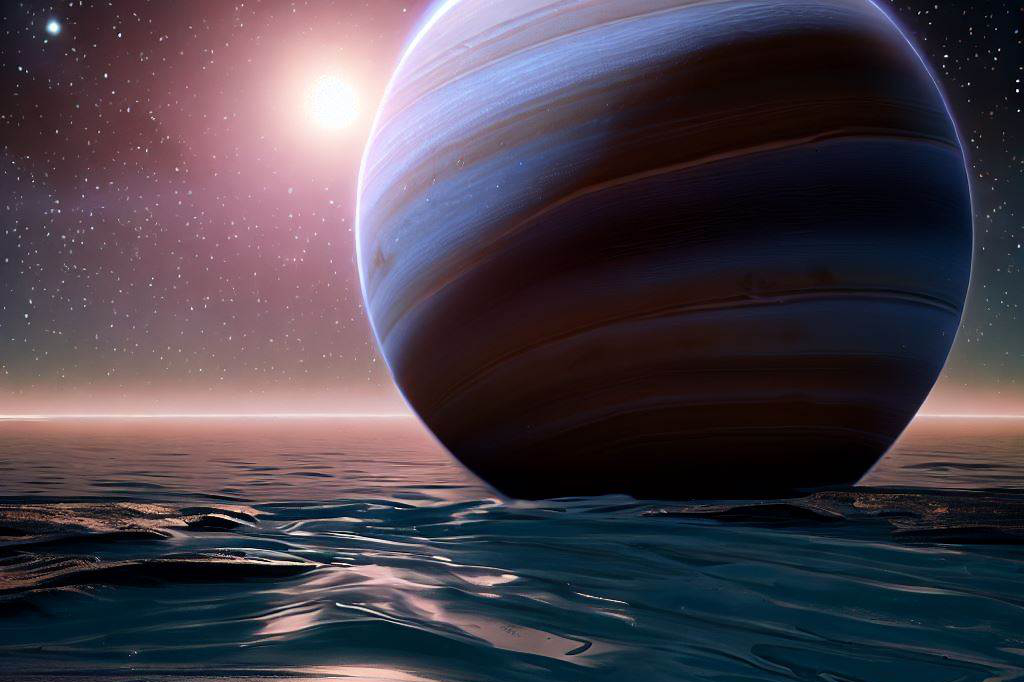The universe is vast and infinitely diverse. For generations, humanity has looked up at the sky with a sense of wonder and awe, pondering what lies beyond our planet. One of the most exciting areas of space exploration is the discovery and study of exoplanets.
Exoplanets, also known as extrasolar planets, are celestial bodies outside our solar system that orbit a star other than the Sun. These planets have captured the imagination of scientists and researchers worldwide because they offer an unprecedented opportunity to explore worlds beyond our own.
Definition of Exoplanets

Exoplanets come in all shapes and sizes, ranging from massive gas giants to smaller rocky planets similar to Earth.
The first exoplanet was discovered in 1995 by Swiss astronomers Michel Mayor and Didier Queloz, who detected a Jupiter-like planet orbiting the star 51 Pegasi using radial velocity measurements.
Since then, over four thousand exoplanets have been confirmed by various detection methods such as
- radial velocity measurements,
- transit photometry,
- gravitational microlensing,
- direct imaging,
- and astrometry.
Importance of Exoplanets in Astrobiology

Exoplanets have become increasingly important in astrobiology because they provide a unique opportunity to search for signs of life beyond Earth. The fundamental question that drives this research is whether or not life exists elsewhere in our galaxy or even beyond it.
By studying exoplanetary atmospheres for biosignatures such as oxygen or methane gas, which could indicate biological processes taking place on those planets. Moreover, studies on these planets can help us understand how planetary systems form and evolve over time, which could provide insights into how our own solar system formed billions of years ago .
Additionally, assessments like these can help us find potentially habitable planets that could one day serve as a future home for humanity. Thus, the discovery and study of exoplanets are essential to expanding our understanding of the universe and our place in it.
History of Exoplanet Discovery

Exoplanets were first theorized in the 16th century by scientists such as Giordano Bruno and Johannes Kepler. However, it wasn’t until the 1990s that the first exoplanets were discovered.
Early methods of exoplanet detection involved observing the wobbling of a star due to the gravitational pull of an orbiting planet or detecting small variations in a star’s brightness caused by a planet transiting in front of it.
In 1995, Swiss astronomers Michel Mayor and Didier Queloz made history by discovering the first exoplanet around a sun-like star.
The gas giant planet named 51 Pegasi b orbits its star every four days and has a mass half that of Jupiter.
This discovery opened up new avenues for research into exoplanetary systems.
Early Discoveries and Methods
Over the next decade, astronomers continued to discover more exoplanets using radial velocity measurements and transit observations. In 2004, NASA’s Spitzer Space Telescope was launched to detect infrared radiation emitted by exoplanets as they passed behind their host stars. This allowed astronomers to study the atmospheres of some exoplanets for the first time.
Another early method used was gravitational microlensing, where an intervening object affects light coming from a background source like a distant star. A massive planet orbiting around that intervening object can bend light in such a way that it magnifies the stars behind them allowing scientists to detect them.
Kepler Mission and its Impact on Exoplanet Discovery
The Kepler mission launched by NASA in March 2009 had an enormous impact on our understanding of exoplanetary systems. It used transit photometry to detect planetary candidates by measuring small dips in brightness when planets crossed their host stars’ disks.
Over the course of four years, Kepler discovered over 2,600 exoplanet candidates, many of which have since been confirmed. These discoveries helped astronomers understand that exoplanets are common and exist in a wide variety of sizes and compositions.
The mission also opened up new avenues for research into habitable-zone planets that could potentially host life. The history of exoplanet discovery is ongoing as advancements in technology and new missions continue to reveal more information about these distant worlds.
Characteristics of Exoplanets

The study of exoplanets has revealed a wide variety of different types, each with their own unique characteristics. Most exoplanets that have been discovered so far fall into two categories: gas giants and rocky planets.
Gas giants, also known as Jovian planets, are similar in composition to Jupiter and Saturn in our solar system.
They are generally large and gaseous, without a solid surface.
Rocky planets, on the other hand, are smaller and more similar to Earth in composition.
They can be further divided into subcategories such as super-Earths (planets larger than Earth but smaller than Neptune) and mini-Neptunes (planets with a thick envelope of gas around a solid core).
One important characteristic of exoplanets is their location within their star’s habitable zone.
This is the region around a star where conditions are just right for liquid water to exist on the surface of a planet. The presence of liquid water is key for the development of life as we know it, making exoplanets within habitable zones particularly interesting targets for astrobiology research.
Types of Exoplanets

Gas giants are typically much larger than rocky planets and can have masses up to 13 times that of Jupiter. They tend to be found farther away from their host stars due to their greater size and gravitational influence.
In addition to being composed mostly of hydrogen and helium gases, they often have thick atmospheres containing methane or ammonia.
Super-Earths represent another common type of exoplanet that has been discovered in abundance by modern telescopes like Kepler or TESS mission launched by NASA over the past decade. Despite being called “super-Earths”, they can range from two times Earth’s radius up to about ten times its mass; some scientists believe these massive exo-planetary bodies could be covered by oceans up to a few hundred kilometers deep.
Habitable Zones and Potential for Life

One of the most exciting prospects in the study of exoplanets is the potential for finding life outside of our own planet. This makes understanding the habitable zones surrounding stars a crucial aspect of exoplanet research.
The habitable zone, also known as the Goldilocks Zone, represents an area around a star where conditions are just right for liquid water to exist on the surface of a planet. The presence of water is a key factor when it comes to assessing whether an exoplanet may be capable of supporting life as we know it.
Other factors that are considered include atmospheric composition, temperature, and the presence of organic molecules.
While there have been some tantalizing hints at possible signs of life on other planets, much more research is needed before we can say with certainty that we have found extraterrestrial life.
Astrobiology and Exoplanets

Search for Extraterrestrial Life on Exoplanets
It is believed that there are at least 100 billion planets in the Milky Way galaxy alone, and with the discovery of exoplanets, the search for extraterrestrial life has become a reality. The search for life beyond Earth is not a new concept, but the discovery of exoplanets has provided scientists with new avenues to explore.
One way scientists search for extraterrestrial life on exoplanets is by looking for biosignatures. Biosignatures are chemical or physical markers that indicate the presence of life.
For example, Earth’s atmosphere is rich in oxygen due to photosynthesis by plants. If scientists detect an atmosphere with a similar oxygen-rich composition on an exoplanet, it could be an indication of life.
Another method used to search for extraterrestrial life is through direct observation of exoplanetary surfaces using telescopes or spacecraft. This method can detect signs of geological activity such as volcanic eruptions or tectonic activity, which could potentially create a habitable environment.
Importance of Studying Exoplanetary Atmospheres

The study of exoplanetary atmospheres has become increasingly important in the field of astrobiology because it can provide insight into whether or not these planets are habitable and whether they contain signs of biological activity. One way scientists study exoplanetary atmospheres is through spectroscopy.
Spectroscopy involves analyzing light emitted or absorbed by atoms and molecules in an atmosphere to determine its composition and structure.
By studying this data, researchers can learn about the temperature, pressure, chemistry, and even potential weather patterns present on these distant worlds. The study of exoplanetary atmospheres can also help refine our understanding of Earth’s own atmosphere and its evolution over time.
By studying how atmospheres change over time, scientists can better understand the factors that may impact habitability and the potential for life to exist on other planets. Overall, the study of exoplanetary atmospheres provides valuable information for understanding our place in the universe and the potential for life beyond Earth.
Challenges in Exoplanet Research

Detection methods limitations
As we continue to search for exoplanets, one of the biggest challenges we face is the difficulty of detecting them. One method that has been successful for finding exoplanets is the transit method, which involves watching a star for small dips in its brightness caused by a planet passing in front of it. However, this method has limitations; not all planets orbit their star in such a way that they pass directly between us and the star.
Additionally, small rocky planets like Earth are difficult to detect using the transit method because they have less impact on their star’s brightness. Another detection method is radial velocity, which measures the slight wobble of a star as it is pulled around by an orbiting planet’s gravity.
However, this method also has its limitations. For example, it can only detect planets relatively close to their stars, and it cannot distinguish between multiple planets influencing the same star.
Technological advancements needed to overcome challenges

To overcome these detection limitations, we need technological advancements that can help us better observe and analyze exoplanetary systems. One area of focus is developing telescopes with greater sensitivity and precision to detect even smaller changes in a star’s brightness or movement.
Another area of research involves studying exoplanetary atmospheres using spectroscopy techniques. By analyzing the light from a planet as it passes in front of its parent star or directly from its atmosphere, we can learn more about its composition and potential habitability.
Advances in data analysis techniques are also crucial for making sense of the massive amounts of data generated by exoplanet discoveries. Machine learning algorithms and other statistical methods are being employed to identify patterns that may indicate the presence of planets or other important features within vast datasets.
The importance of overcoming these challenges
Despite these challenges in detecting and studying exoplanets, it is crucial that we continue to push the boundaries of our technological capabilities. Exoplanets have the potential to unlock some of the biggest mysteries in astrobiology, such as whether or not we are alone in the universe. By overcoming these challenges, we can increase our chances of discovering truly habitable worlds beyond our solar system and learn more about how planetary systems form and evolve over time.
Future Directions in Exoplanet Research

Missions to explore exo-planetary systems
The search for exoplanets is an ongoing process, and as technology advances, so does our ability to detect and study these distant worlds. One exciting area of research in exoplanet science is the development of new missions designed specifically to explore and characterize exoplanetary systems.
One such mission is the James Webb Space Telescope (JWST). JWST is equipped with advanced instruments that enables it to detect and study the atmospheres of exoplanets, providing valuable insights into their composition and potential habitability.
Another mission is the European Space Agency’s Characterizing ExOPlanets Satellite (CHEOPS), which focuses on studying known exoplanets in detail, with a particular focus on measuring their sizes and masses.
Other proposed missions include the New Worlds Observer (NWO), which would use a space-based telescope system to directly image Earth-like planets around nearby stars, and Habitable Exoplanet Observatory (HabEx), a mission aimed at identifying potentially habitable planets by searching for signs of water vapor and other biomarkers in their atmospheres.
Prospects for discovering habitable planets

The discovery of potentially habitable exoplanets has been one of the most exciting developments in astronomy over the past few decades. While we have yet to find definitive evidence of life beyond Earth, the identification of planets that could potentially support life has fueled speculation about what kind of organisms might exist on these worlds.
One promising avenue for finding habitable planets is through transit photometry, a technique used by NASA’s Kepler Mission that measures small dips in a star’s brightness caused by a planet passing in front of it. A number of potentially habitable planets have been discovered using this method, including TRAPPIST-1f, a planet roughly the size of Earth that orbits in the habitable zone of its host star.
Another promising approach is through direct imaging, which involves taking pictures of exoplanets as they orbit their host stars. While this technique is much more difficult than transit photometry, it has the potential to provide detailed information about an exoplanet’s atmosphere and composition.
Overall, the prospects for discovering habitable planets are strong, with new missions and detection techniques constantly being developed. While we may still be many years away from finding definitive evidence of life beyond Earth, each new discovery brings us closer to understanding our place in the universe.
Final Thoughts

Exoplanet research represents one of the most exciting and rapidly-developing areas of astrobiology. From early discoveries using radial velocity measurements to recent advancements in transit photometry and direct imaging, our knowledge and understanding of exoplanets has grown by leaps and bounds over the past few decades.
As we look toward the future, new missions such as JWST and CHEOPS hold great promise for expanding our understanding of these distant worlds. And while we may not yet have found evidence of life beyond Earth, our ongoing search for potentially habitable planets underscores the profound questions that drive astrobiology as a field.
Ultimately, whether or not we find life elsewhere in the universe remains to be seen. But one thing is certain: our growing knowledge of exoplanets has already transformed our understanding of what it means to be alive on a cosmic scale.

C M, a seasoned editor, journalist, and consultant, is deeply fascinated by the convergence of technology, space, and the future of humanity.
With a particular interest in transhumanity, futurology, and the philosophical and ethical dimensions of these domains, C M serves as the lead contributor to SpaceSpotlight and TranscendSphere.
When not penning insightful articles on these rapidly evolving fields, C M indulges in their love for podcasts and books, proudly embracing their status as a ‘Happy Nerd Extraordinaire!’



